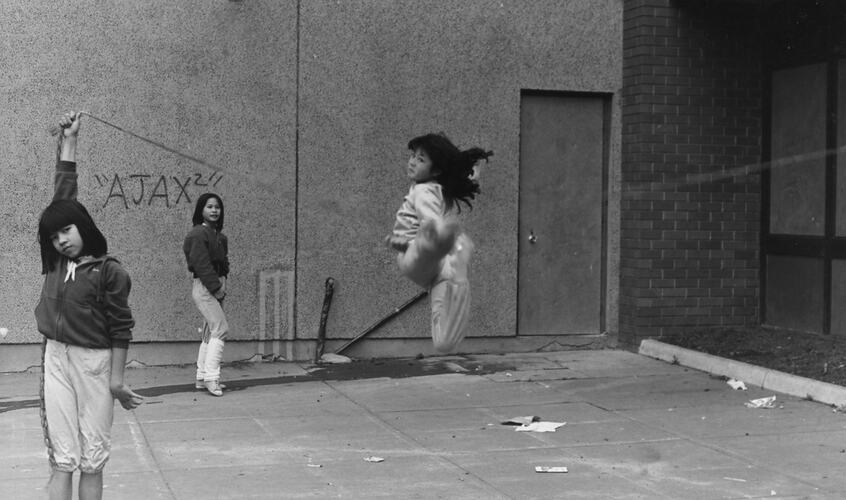England, Ireland, Scotland, Wales; Inside outside puppy dogs tales
Elastics first attracted the interest of children's folklorists in the 1960s. Research in 1987 by French folklorist Andy Aleo revealed that the game was generally reported to have appeared in Europe and Australia in the 1960s with some earlier reports coming from Asia. Sewing elastic was generally used to play the game as was knotted rubber bands. In the US the game was popularly known as Chinese Jump Rope.
Amercian folklorist Dorothy Howard listed elastics in the index of games collected during her six-month Australian field trip in 1955, with one observation documented. Elastics is likely to have begun its popularity at this time following availability of elastic materials used in clothing.
Editors of the Australian Children's Folklore Newsletter (ACFN) took quite an interest in elastics as it was to some extent a 'new' game tradition in Australian playgrounds. The ACFN was edited by June Factor and Gwenda Davey from 1981 to 2016 and renamed Play and Folklore in 1997. In 1991 and 1992 articles by Andy Arleo were published detailing different elastics games and variants across Europe including jumping patterns and rhymes. The ARC 'Childhood Tradition and Change' project carried out in 2011 demonstrated that elastics continues to be played in school playgrounds in Australia.
The game most common in Australia involves two people holding the elastic around their ankles to create a rectangular space for the jumper to jump in, out and over according to a designated pattern, and sometimes accompanied by a rhyme. When this level is mastered the elastic is moved higher up to knees where the same procedure is repeated. The higher the elastic the harder the task!
With the arrival in Australia of large numbers of immigrant children from south-east Asia in the early 1980s a different game style appeared in some school playgrounds.
In 1981 students from the (then) Institute of Early Childhood Development documented the play habits of recently arrived children from Vietnam and Cambodia at the Eastbridge Language Centre in Blackburn South Primary School in Melbourne. Their video recording called Just a Little Bit Different features an elastics game using a chain made of rubber bands. The ritual to create the chain was called butterflies and needed two hands and the toes of both feet to loop the rubber bands together.
In 1986 the 'Play and Friendships in a Multicultural Playground' project documented the same variant, called High Jump, in another inner suburban playground. A single string of elastic or rubber band chain is held between two people and the jumper has to jump over the elastic without touching it - first at knee height, then higher at 'underbums' and then waist height. Once waist height is reached (or another predetermined level) the jumper can touch the elastic with their foot as they jump, sometimes using a cartwheel to bring it down. The elastic is moved higher until the people holding the ends have their arm up at full stretch. This is called straight arm and requires remarkable agility and skill to successfully bring the elastic down.
Elastics is a game known worldwide requiring both physical dexterity, agility and practice to master the jumping patterns. With many variants and levels of difficulty players of varying ages and abilities can play as each player advances at their own rate. All you need is a string of elastic or a box of rubber bands!
References
Darian-Smith K. & Henningham, N., 2011. Final Report of the Childhood, Tradition and Change Project.
Darian-Smith K. & Factor J. (Eds), 2005. Child's Play: Dorothy Howard and the Folklore of Australian Children, Museum Victoria.
Russell, H., 1986. Play and Friendships in a Multicultural Playground. Australian Children's Folklore Publications, Melbourne.
Factor J. & Davey G. (Eds), 1982. Play and Folklore, Issue No. 3. Museums Victoria.
Factor J. & Davey G. (Eds), 1990. Play and Folklore: Issue No 19. Museums Victoria.
Factor J. & Davey G. (Eds), 1991. Play and Folklore: Issue No 20. Museums, Victoria.
More Information
-
Keywords
-
Localities
-
Authors
-
Article types

